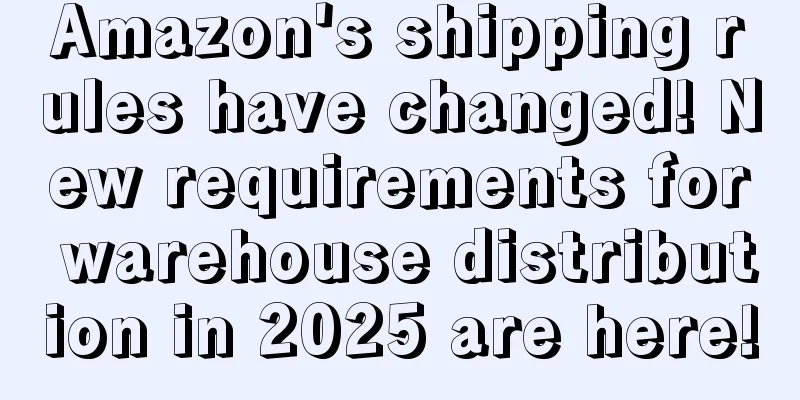Amazon's shipping rules have changed! New requirements for warehouse distribution in 2025 are here!

|
Recently, Amazon has adjusted its shipping rules again! Starting from February 20, 2024, Amazon will make new adjustments to the FBA warehousing configuration, especially for the shipment of standard-size goods, and sellers’ operating space will become smaller again! Based on the current rules, sellers have three inventory entry configuration options: Minimum Shipment Split: Products are shipped to the fewest incoming warehouse locations (usually only one), which is more expensive; Partial shipment splitting: Goods are sent to multiple warehouse locations (usually 2-3 locations), which is less expensive; Amazon-recommended optimal shipping locations: Distribute products to multiple locations (usually 4 or more) at no charge. However, Amazon is now bringing new challenges to sellers - starting from February 20, 2025, the "partial shipment split" option will be cancelled and replaced by "Amazon optimized shipment split" and "minimum shipment split" modes. So what do these two modes mean? Let's take a closer look: Amazon Optimized Shipment Split
Each product (SKU) must contain at least 5 identical cartons or pallets; The mix of products in each box or pallet is the same, and the quantity of products in each box is the same; If sellers can meet these conditions and ship to multiple Amazon fulfillment centers, they can enjoy this free policy. Minimum Shipment Split
It should be noted that for large and bulky items (such as large furniture, home appliances, etc.), the delivery method remains unchanged. Sellers can still choose "Minimum Shipment Split" and make regional selections, and the "Partial Shipment Split" option for "Large Items" will continue to be retained.
Previously, "Amazon optimized shipment splitting" only required shipments to four locations, but now it requires at least five locations, which undoubtedly increases the difficulty of sellers' logistics operations; If sellers fail to meet the new regulations, it may result in additional warehousing configuration service fees and operational complexity; One seller stated that when he tried to distribute goods to five warehouses, the delay of the fifth batch of goods resulted in a 30-day difference between the first and last batches of goods entering the warehouse, and he was forced to pay the warehouse defect fee. How to deal with these new regulations?Stock up in advance: Avoid inventory backlogs and stockouts through more accurate sales forecasts and inventory management. Cooperation with overseas warehouses: You can consider sending inventory to overseas warehouses in advance and adopt a "transit replenishment" model to balance the uncertainty and out-of-stock risks brought about by separate warehouses. Today's Share 2025 Amazon Listing Title New Rules Guide |
<<: Amazon's weird new rules! Setting a threshold for order processing?
>>: Big changes on Amazon! New rules for account verification and DOE certification are coming!
Recommend
What is Ideeli? Ideeli Review
Ideeli was founded in 2007 and is an e-commerce we...
Over 158 million people will go shopping! The US Super Saturday shopping festival is coming!
<span data-docs-delta="[[20,"获悉,根据美国零售联合会和...
The battle for the US toy market has begun! What will you compete for this holiday season?
It is learned that on August 30, Walmart released ...
What is Title Builder? Title Builder Review
Title Builder is a tool that helps eBay sellers op...
What is deerfamy? Deerfamy Review
deerfamy is committed to developing quality campin...
New features added? Amazon's dark horse site is about to take off
The Japanese site’s performance on Prime Day this...
How to train new employees to be independent? A young girl who just graduated keeps procrastinating because she is afraid to take action. Should we be more tolerant?
Drowning Dog My C position The young girl who had ...
Flipkart adds three new distribution centers! Will create more than 14,000 jobs!
New Delhi: Walmart-owned Flipkart on Thursday said...
Wayfair released its second quarter financial report, with a gross profit margin of more than 30%
It is learned that on August 2, Wayfair, the US ho...
Create a B2B version of "Prime Membership"! New features bring new business opportunities
Walmart recently announced that it will launch a n...
Confusing behavior! Amazon sellers’ brands were removed and A+ disappeared...
During this period, a series of actions by Amazon ...
What is BuzzStream? BuzzStream Review
BuzzStream is a link building SEO tool that enable...
Do you understand the tips on how to drive traffic outside of Amazon?
Many friends actually don’t know which Amazon sel...
What is ONT8? ONT8 Review
ONT8 is one of Amazon's two largest warehouses...
FBA warehouses will be forced to open for investigation! Amazon is in big trouble
This week started off really well for my brother-...









